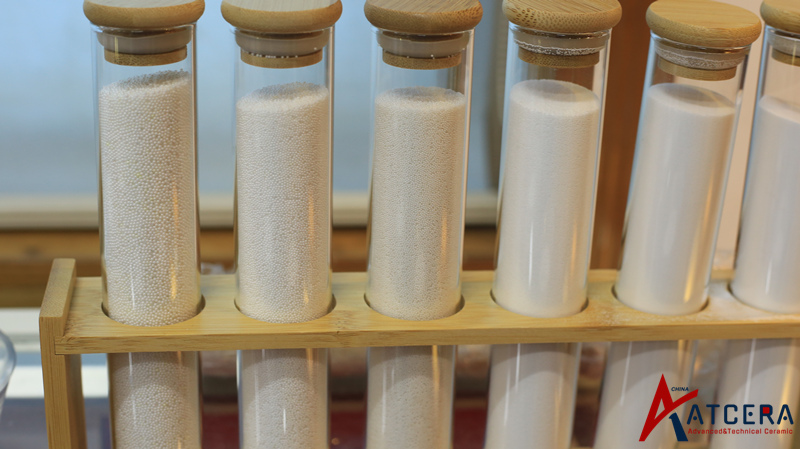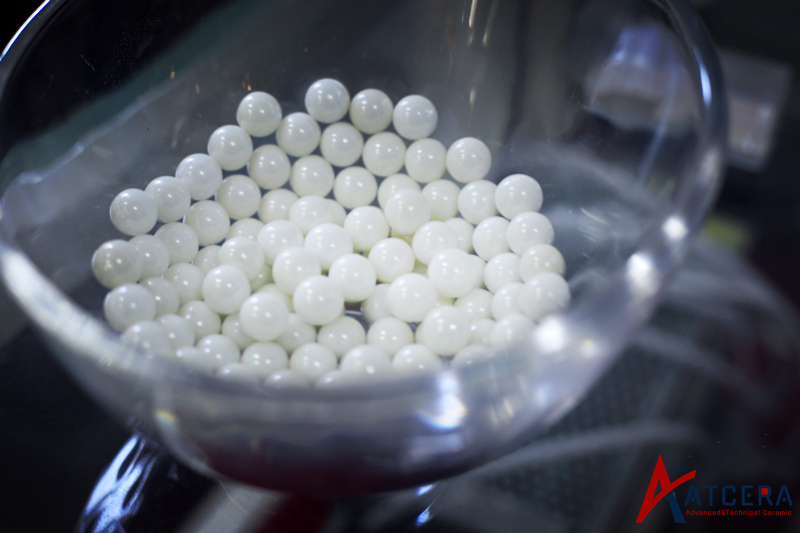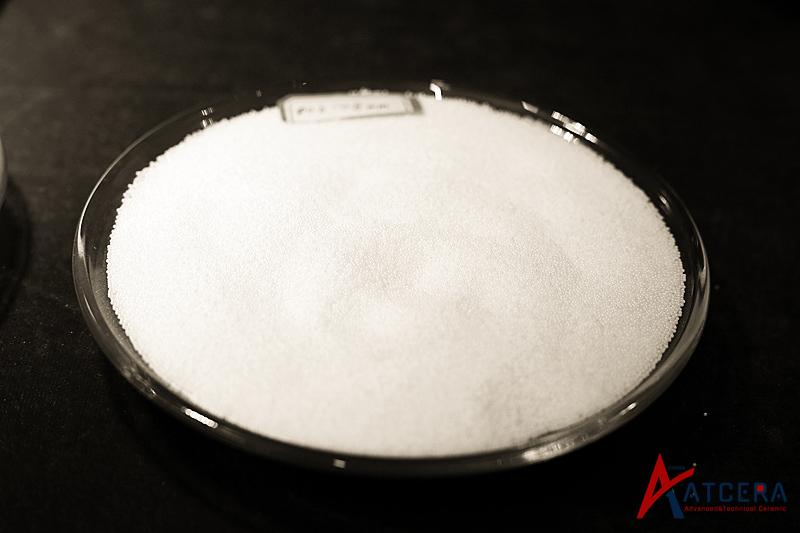Zirconia, characterized by its high melting and boiling points, as well as its hardness, is an insulator at room temperature yet exhibits excellent electrical conductivity at high temperatures. Consequently, it holds immense potential for applications in various fields such as mechanics, electronics, optics, biology, and catalysis, serving as both structural and functional ceramic materials. Moreover, zirconia plays a pivotal "supporting role" in the production of advanced ceramics, where adding a small amount of zirconia can significantly enhance the performance of other ceramic materials.
I. Zirconia-Toughened Alumina Composite Ceramics
The martensitic phase transformation property of ZrO2 enhances the fracture toughness and flexural strength of ceramic materials, imparting them with excellent mechanical properties. Additionally, zirconia's low thermal conductivity and excellent thermal shock resistance can alleviate the brittleness issue of ceramic materials. In summary, toughening primarily utilizes the martensitic phase transformation of ZrO2, which absorbs the energy generated during the transition from the tetragonal structure to the monoclinic structure, inhibiting crack propagation and extension.
Based on this mechanism, the introduction of zirconia into Al2O3 ceramic results in zirconia-toughened alumina (ZTA) ceramics. ZrO2 exhibits phase transformation toughening and microcrack toughening effects in Al2O3 ceramics, strengthening and toughening the material. As a result, ZTA ceramics are considered one of the most promising materials in structural ceramics.

II. The Impact of Zirconia on the Thermal Shock Resistance of Magnesia Ceramics
Magnesia ceramic possesses excellent high-temperature resistance, electrical insulation, and strong resistance to alkaline metal slags. It is chemically inert to metals such as magnesium, nickel, uranium, thorium, zinc, aluminum, iron, copper, and platinum, making it suitable for applications like crucibles for metal smelting, molds for metal casting, protective tubes for high-temperature thermocouples, and lining materials for high-temperature furnaces. However, under conditions of rapid temperature changes (thermal shock), the strength of magnesia ceramics significantly decreases, leading to spalling or even brittleness, thereby reducing its service safety and reliability. Therefore, enhancing the thermal shock resistance of magnesia ceramics and extending its service life at high temperatures are of significant practical importance.
Research has revealed that adding nano-monoclinic zirconia can improve the microstructural uniformity of magnesia ceramics, reduce sintering temperatures, and promote sample densification. Samples with nano-monoclinic zirconia additions exhibit enhanced thermal shock resistance through microcrack toughening, phase transformation toughening, and microcrack deflection toughening.
III. The Impact of Zirconia on Ceramic Binders for Superhard Abrasives
Low-temperature ceramic binders are a crucial component in the preparation of high-performance ceramic-bonded superhard abrasives (diamond, cubic boron nitride), and their properties directly influence the overall performance of these abrasives. Basic performance requirements for ceramic binders in superhard abrasives include high strength, low softening and melting temperatures, small thermal expansion coefficients, and good wetting properties at high temperatures. Additionally, due to the high hardness and wear resistance of superhard abrasive particles, most ceramic binders for superhard abrasives are used at relatively high rotational speeds. Therefore, to ensure that abrasive particles can fully exert their grinding performance, ceramic binders for superhard abrasives must possess high strength.
By utilizing the B2O3-Al2O3-SiO2 system as the base ceramic binder and adding varying amounts of nano-ZrO2 as an additive, researchers have studied the effect of its content on the structure and properties of ceramic binders. The results indicate that with the increasing content of nano-ZrO2, the overall performance reaches its peak when the content is 8%, exhibiting a flexural strength of 63.41 MPa and a Rockwell hardness of 129.8 HRC. The ceramic binder also exhibits uniform pore distribution and a good microstructure.
In another study, researchers prepared ceramic binders by incorporating ZrO2 into a Na2O-Al2O3-B2O3-SiO2-based glass and investigated the effect of ZrO2 content on the performance of cubic boron nitride abrasives. The results showed that as the ZrO2 content increases, the high-temperature fluidity decreases, and ZrO2 promotes crystallization in the glass phase. When the ZrO2 content is 1%, the hardness of the abrasive test strip reaches HRB110.6, and the flexural strength increases by 27.9% to 68.23 MPa. Additionally, the wear resistance improves significantly, with a wear ratio increase of 119%.

IV. The Impact of Zirconia on Corundum-Based Ceramics
Corundum-based ceramic regenerative bodies possess several advantages, including excellent chemical stability, high temperature resistance, erosion resistance, and superior strength. However, they are prone to brittleness and poor thermal shock resistance. Currently, there is a wealth of literature exploring the enhancement of thermal shock resistance and toughening of corundum-based ceramics through nano-ZrO2.
Through research on the properties of nano-zirconia-toughened corundum-based ceramic regenerative bodies, it has been discovered that nano-ZrO2, as a second-phase particle, is dispersed within the ceramic matrix, enhancing its strength and thermal shock resistance. The toughening effect of nano-ZrO2 is closely related to its crystalline phase. When all the introduced ZrO2 is in the cubic phase, phase transformation toughening does not occur, resulting in only minor microcrack toughening. Conversely, the presence of an appropriate amount of tetragonal and monoclinic ZrO2 phases leads to a synergistic effect of phase transformation toughening and microcrack toughening, significantly improving the toughness of the corundum-based ceramic regenerative body.
V. The Impact of Zirconia on the Microstructure and Mechanical Properties of Hot-Pressed AlN Ceramics
AlN ceramics, renowned for their high thermal conductivity, excellent electrical properties, and low thermal expansion coefficient, are ideal materials for circuit packaging substrates. However, compared to ceramic materials like Si3N4 and SiC, AlN ceramics exhibit lower fracture toughness, which compromises their thermal shock resistance and increases machining difficulty.
Research involving the addition of nano-ZrO2 powder, combined with Y2O3 sintering aids, has been conducted to fabricate AlN ceramics through hot-press sintering. The results indicate that the phases of the hot-pressed AlN ceramic include the primary AlN phase, the Al5Y3O12 grain boundary phase, and the new ZrN phase. With the addition of ZrO2, the Vickers hardness of the hot-pressed AlN ceramic remains largely unchanged, while its fracture toughness gradually improves.

VI. The Impact of Zirconia Doping on the Structure and Dielectric Properties of BaTiO3 Ceramics
Electronic ceramics, as a type of electromagnetic functional ceramics, have garnered significant attention in recent years. Among them, barium titanate ceramics are widely used in various sensors and chip capacitors due to their high dielectric constant and excellent ferroelectric properties. However, the Curie temperature of pure barium titanate is 120°C, limiting its applicability at room temperature. To enhance the dielectric properties of barium titanate-based ceramic materials, researchers have explored doping various oxides, resulting in a partial understanding of the relationship between dopant oxides and material properties.
Using BaCO3, TiO2, and ZrO2 as raw materials, researchers have prepared barium zirconate titanate (BZT) ceramics with different Zr contents through solid-phase sintering. It has been observed that with increasing ZrO2 doping, the grain growth of BZT ceramics becomes more regular, with tightly arranged particles, clear contours, and a high surface density. At a Zr4+ doping level of 20% in room temperature environments, BZT ceramics exhibit the highest dielectric constant and the lowest dielectric loss.
Conclusion
Apart from the aforementioned ceramics, numerous researchers have also investigated the influence of zirconia in other ceramic systems. For instance, studies have revealed that ZrO2 primarily exists as a second phase in the grain boundaries, inhibiting grain growth without reacting with ZnO grains. Additionally, ZrO2 has been found to effectively promote the sintering of BaCo0.194Zn0.116Nb0.69O3 microwave dielectric ceramics at low temperatures.



























